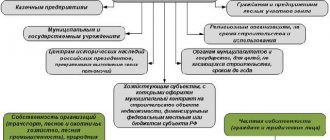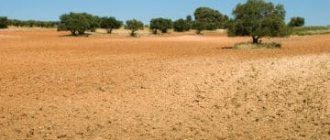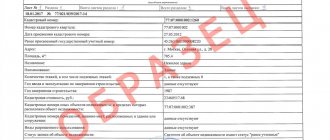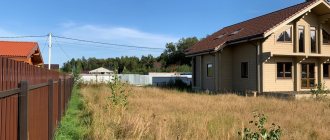Determining the procedure for using a land plot in shared ownership
Expert opinion
Stanislav Evseev
Lawyer. Experience 12 years. Specialization: civil, family, inheritance law.
Shared ownership is an abstract concept. The owner does not have the right to a specific part of an indivisible thing. If the plot is in shared ownership, then the co-owners do not have a certain part to use at their discretion. In addition, a share of the land plot cannot be rented out.
The absence of defined boundaries may interfere with the exploitation of the allotment. In addition, if the object does not allow the allocation of a share in kind, then the situation may lead the parties to a dead end.
The owner of the share has the right to raise the issue of determining the principle of use. In this case, the parties separate part of the site from the general area. But changes are not made to the cadastral passport and the Unified State Register. The selection has a formal appearance. There are no legal changes to the object.
Why contact a lawyer
Land relations in Russia are extremely complex due to historical circumstances, imperfection of land legislation and little experience of the judicial system in resolving such disputes. A person interested in a positive solution to his problems must take into account a large amount of varied information. The presence of a lawyer with professional knowledge in this matter will help assess the plaintiff’s chances, prepare all the necessary documents and carry out the case in court.
Land disputes usually last a long time and are extremely costly; an experienced lawyer will help find a compromise solution and save the plaintiff considerable sums.
The presence of a lawyer will help predict possible unpleasant moments and tilt the court in favor of the plaintiff.
Reasons for determining the order of use
In practice, the following reasons arise in which it is necessary to resort to determining the principle of land use:
- The owners are not related, but own shares in the same plot. For example, if there is a residential building on the land. Owners of apartments in the house have equal rights to the plot on which the house is located.
- One of the shares was bought by the new owner. Moreover, he is not satisfied with the current procedure for use.
- The object was received by the owners as an inheritance. Sharing of allotments is difficult.
Important! A prerequisite for determining the principle of land use is the impossibility of allocating a share in kind (minimum plot size).
Service cost
The complexity of land legislation requires consultation with a highly professional lawyer. Due to the complexity of such litigation, he cannot handle several cases at the same time, which makes his services quite expensive. There is no point in saving money - only with the involvement of such a specialist can one hope for a favorable outcome of the trial, otherwise the funds for paying for court preparation services will be wasted. You can ask our specialists all questions. The first consultation is provided free of charge.
Voluntarily
The parties can independently determine the procedure for using the facility. To legally confirm the decision made and to avoid future disputes, it is necessary to formalize an agreement.
An agreement is understood as a document that contains a decision of the parties on the use of the allotment, made on a voluntary basis. A prerequisite is written form. Notarization is not provided for by law, but the parties can contact a notary office on their own initiative.
The document must include the following information:
- Name;
- date and place of imprisonment;
- data of co-owners;
- information about the site (total area, cadastral number, address);
- details of title documents;
- information about the size of shares;
- information about the extract from the Unified State Register of Real Estate in relation to the allotment;
- procedure for using the allotment;
- the principle of using the common territory;
- rights and obligations of co-owners;
- liability for violation of conditions;
- signatures of the parties.
Issues to be addressed by the agreement
| No. | Possible controversial issues |
| 1 | Rules for the use of common areas and communications |
| 2 | Possibility to erect outbuildings |
| 3 | Possibility of growing garden and vegetable crops |
| 4 | Possibility of equipping improvement facilities |
| 5 | Additional controversial issues |
Sample agreement to determine the procedure for using a land plot in shared ownership
Sample agreement
Basic rules when using land
The legislation provides that all participants in shared ownership use the property within the framework of the agreement reached by them (clause 1 of Article 247 of the Civil Code of the Russian Federation). Problems arise when owners cannot agree on how and in what order the common area should be used. You can resolve the conflict as follows:
- Decide on the goal: allocating a real or ideal share. An ideal share is a classic version of shared ownership. The documents indicate that the owner owns a certain part of the plot - in the form of a fraction (1/2, 1/4, etc.). The real share (or taking out in kind) is a part of the land, with boundaries officially established on the ground.
- Try to resolve the conflict peacefully. You can resolve the dispute yourself or with the invitation of an expert. The decision made on the procedure for using the site is recorded by agreement in writing.
- Go to court if the problem cannot be resolved peacefully.
Setting boundaries
The process of conflict resolution should begin by defining clear boundaries of the disputed area. The exact coordinates of the object are indicated in the cadastral passport. To draw up a document, a land surveying procedure is carried out, which records:
- total area of the site;
- coordination of its boundaries with neighboring areas.
Land surveying is carried out by a cadastral engineer (from the territorial branch of Rosreestr or a licensed private company).
The specialist takes the necessary measurements and places the boundaries of the site on the ground. This means that special boundary signs are being installed that reflect the exact location of the land property. All received data is recorded in the cadastral passport.
How to determine boundaries on the ground?
How to determine the boundaries of land according to shares? If the participants in shared ownership agree to a formal division of land plots (in proportion to their shares), then the cadastral engineer can also mark the internal boundaries of the land. In this case, boundary markers will determine the specific location of each owner’s share. All measurements are documented.
In the case where it is impossible to allocate a real share in the plot, or the participants disagree with the formal allocation of square meters of land, the conflict can be resolved in another way: by signing an agreement.
Conclusion of an agreement on shared use of storage space
This is a pre-trial option for resolving a dispute. All participants in common ownership must determine a clear procedure for using the site: what remains in joint ownership (common use territory), what goes to each specific owner.
The agreement reached is secured in a written agreement on the procedure for use. It should contain:
- information about all owners;
- data on the size of shares owned by each (with reference to title documents);
- a list of conditions on which agreement was reached;
- signatures of the parties to the agreement and the date of its conclusion.
Note! The agreement does not require mandatory notarization.
If you cannot independently establish the rules for disposing of the land, you can conduct a land management examination.
Conducting land management examination
As part of the procedure, the expert develops several options for using the land plot. The decision is made taking into account the interests of all parties to the dispute and based on current legislation.
Options for using a land plot may include the right to individual disposal of certain parts of it by each of the participants separately, as well as common (joint) ownership of certain territories (for example, for the passage of persons, or the passage of cars, etc.).
Based on the expert’s opinion, an agreement on the joint use of the site is also drawn up. If the expert’s services do not help - one or all owners do not agree with his conclusion, the dispute is resolved in court.
Going to court if it is not possible to reach an agreement peacefully
The legislation allows for the resolution of land disputes through the courts in cases where it was not possible to resolve the conflict peacefully.
Where to file a claim?
Such disputes are resolved by a magistrate (Article 23 of the Code of Civil Procedure of the Russian Federation). The claim is filed in the magistrate's court at the address of the location of the land plot (part 1 of article 30 of the Code of Civil Procedure of the Russian Federation).
What to include in the claim?
Specific requirements for the content of the claim are established by Art. 131 and art. 132 Code of Civil Procedure. In particular, it must contain:
- court details;
- information about the plaintiff and defendant;
- subject of the dispute (determination of the order of use of the site);
- a detailed description of all the facts and events that led to the trial (violation of the order of use of the land plot, or the impossibility of determining such an order, as well as information about attempts to voluntarily resolve the dispute);
- The plaintiff's demand is to determine the procedure for use.
What documents should I attach?
The following documents must be attached to the claim:
- confirming ownership of the share;
- a receipt for payment of the mandatory state fee;
Spending
When filing a claim, you will need to pay a fee of 300 rubles (clause 3, clause 1, article 333.19 of the Tax Code of the Russian Federation).
Judgment
When considering a case, the court relies on the established procedure for using property. Formally, it may not correspond to the established shares.
Additionally, the following are taken into account: the need of each co-owner for a plot of land, the real possibility of joint use. (paragraph 2, paragraph 37, Resolution of the Plenum of the Supreme Court of the Russian Federation No. 6, Plenum of the Supreme Arbitration Court of the Russian Federation No. 8). Based on the results, a decision is made, which is recorded in the form of a document. It will spell out the specific procedure for using common property. This is an official legal act. When transferring a share (by sale or gift), the assigned right to use the site will be transferred to the new owner in full.
Through the world court
If the parties were unable to reach an agreement on a voluntary basis, then the issue can be resolved through a magistrates' court. The procedure is carried out according to the procedure of claim proceedings. Evidence must be attached to the application.
The application is submitted at the location of the land plot. Since land refers to objects in respect of which special jurisdiction applies.
List of documentation:
- passport;
- title documents;
- extract from the Unified State Register of Real Estate;
- cadastral passport;
- documents for buildings.
To make a decision, the court is guided by the established procedure for using the object. However, the parties must prove that such rules have been established. For example, attract witnesses.
When establishing the principle, the court proceeds from the size of the share owned by the applicant. Depending on the size of the share, the area of part of the plot is calculated. However, this does not mean that the court will allow it to be isolated in full. Part of the territory can be used as common property.
In special cases, the court may order a land management examination. The specialist will study the situation and provide the court with one or more principles of use.
Important! The procedure for use does not apply to property claims. Therefore, the applicant will pay a fee of 300 rubles.
Required documents
Before filing a claim, you should definitely obtain an expert’s opinion with an assessment of the site and possible options for its use or division. Expert opinion helps make a judicial decision, but, as courts say, does not influence it. With the help of an expert, the court receives answers to the following questions:
- is there any development on the disputed territory;
- can an object exist independently;
- what is the exact area of the site;
- are there any discrepancies with documents on this indicator;
- whether the plot is located within the boundaries allocated to it according to cadastral data;
- possible options for division or use in accordance with shares;
- can monetary compensation be awarded for the transfer of a larger share, and in what amount;
- whether work is needed to clear and move buildings or plantings.
- existing restrictions on the use of the plot (sanitary and hazardous areas).
Note!
The court may need a document confirming the value of the land to determine the price of the application and the amount of the fee.
To carry out expert work, the specialist is given copies of all title documents for real estate.









